
The flawed open selection system is exposed by the national team's poor performance; despite being a former regional powerhouse, Nepali age-group football now struggles in SAFF, failing to reach finals consistently in recent years.
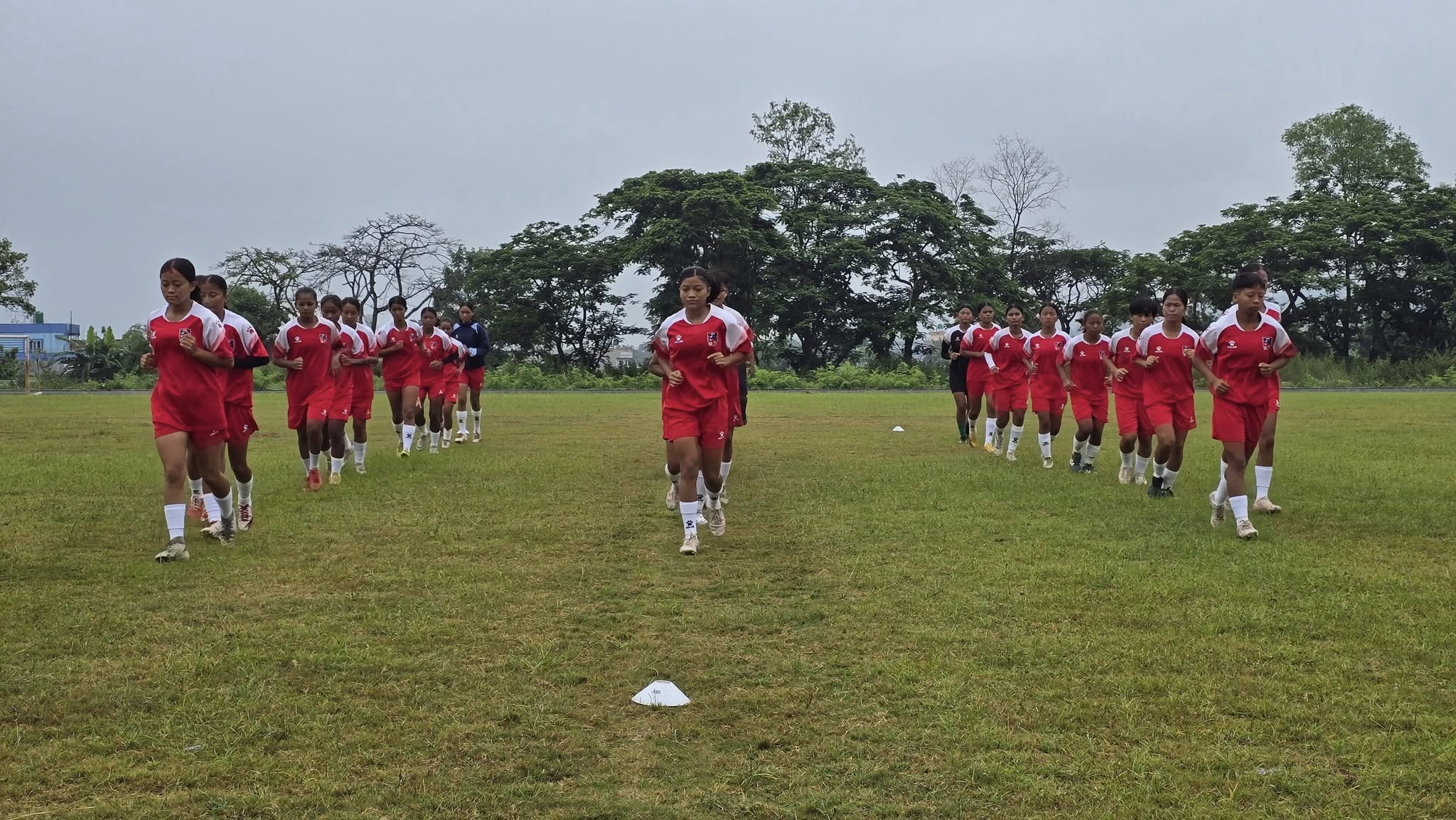
KATHMANDU: For supporters who follow Nepali domestic football, Birsana Chaudhary is no longer a name to be forgotten. Representing the Dhangadhi Sub-Metropolitan City in the Deputy Mayor Cup National Women’s League Qualifier, which was concluded in October 2021 and crowned champion, she has now reached the departmental team Nepal Police Club within an interval of three years. Not only that, this 17-year-old midfielder has already represented Nepal with the U-19 team. And, she has also participated in the Bhutanese League.
What more proof is there left for a footballer to provide than this? But, it may be surprising, even she had to stand in the line for the open selection again to secure a spot in the team traveling to Bangladesh to play in the SAFF U-20 Championship and to Bhutan to play in the AFC Asian Cup Qualifier.
It’s not just Birsana; more than 18 out of 23 players, including Maya Maskey, Barsha Oli, Senu Pariyar, and Mina Deuba, had already showcased their abilities in the ANFA Women’s League held at the ANFA Complex in Satdobato last year. Some of them have been playing continuously from U-16, U-19 to the Senior League.
Furthermore, some players are even members of departmental clubs. In their selection, the natural process involves the coach and regular evaluation. Despite all this, ANFA organized a three-day open selection in June last year. In that, these very proven players were again made to provide evidence of their excellence.
ANFA has not only spent time but also a significant amount of money on the three-day selection and the subsequent preparation. Expenses are incurred on accommodation, food, transportation, coaches, management, match video analysis, and medical tests for the players.
Pralaya Raj Bhandari, a former player and a member of the first batch of the ANFA Academy, says that if players whose selection is almost certain are called to the open selection again, there is room for questions.
He says, “To check if players who have played regularly in the Senior League and age groups for three years are fit or not is just a technical matter. This is just a football drill. Instead of promoting them, holding open selections again and again is an inconsistency.”
At one time in Nepali football, there was a practice where players were not forced to prove themselves repeatedly. In 1999 the ANFA Academy was established for the first time in a South Asian nation.
The main objective of this academy was to gather talented youth players from all over the country in one place through open selection. The aim was to provide them with continuous training for years and build a strong team based on that preparation.
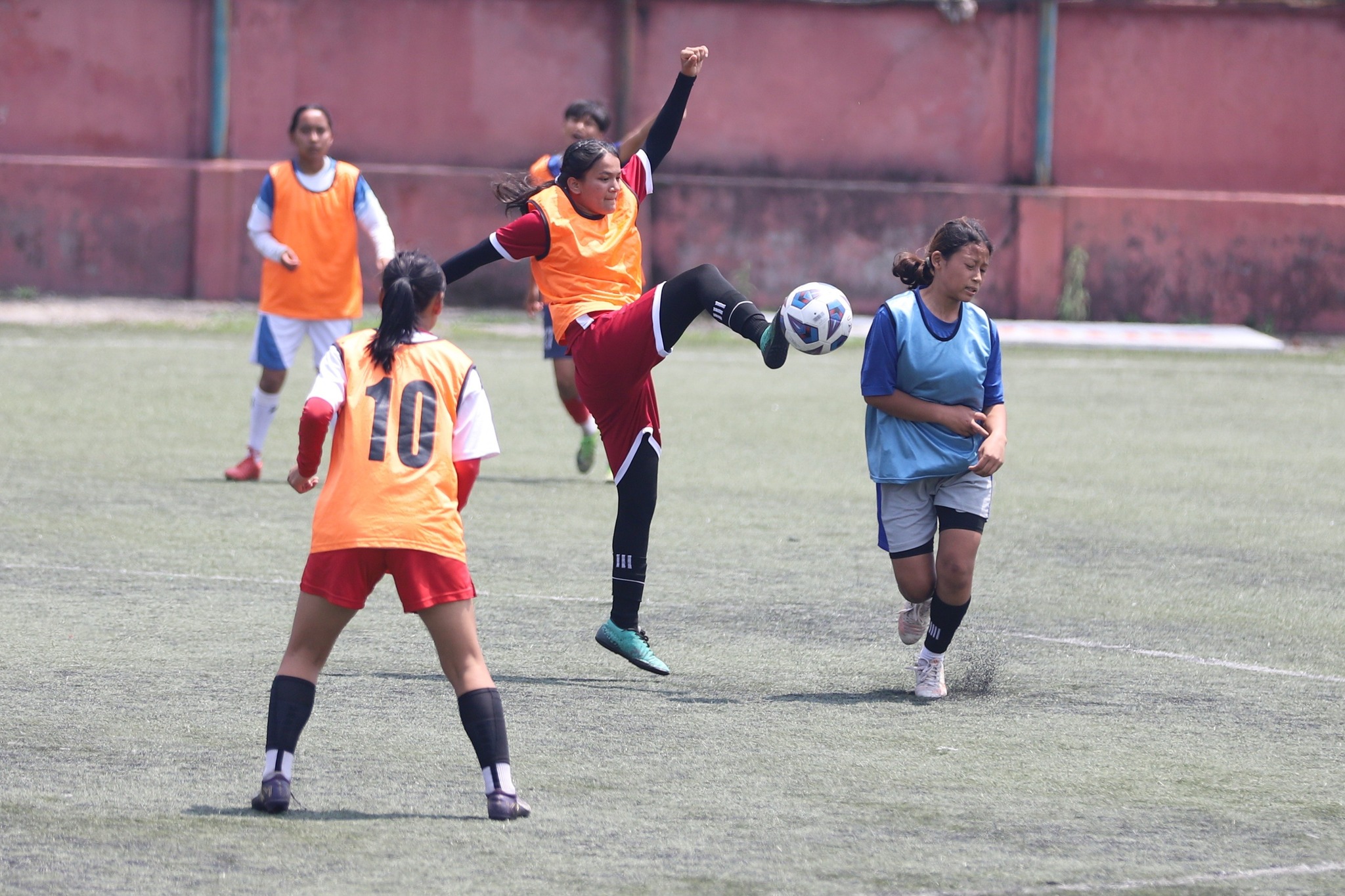
U-20 Women’s National Team Selection. Photo Courtesy: ANFA
At that time, there were 40 players in the academy who had come through open selection from all over the country at once. Pralaya is one of them. There was no need to hold an open selection when a national or international tournament was approaching.
A permanent group of trained and practicing players was already prepared before the coach. Those players would automatically be included in the team. However, in special circumstances, if any kind of weakness or necessity was seen, players who had already proven themselves in the domestic league were also given a place.
Many names like Janak Singh Tharu, Sagar Thapa, Surendra Tamang, and Rajendra Tamang are players who proved themselves in the league and reached the age-group national team even though they were not selected for the academy at that time. Since they had proven themselves for years based on training, competition, and discipline, they did not have to face the hassle of repeating the selection process. They just needed the continuity of it. That is, the fundamental idea of football at that time was not based on open selection, but on ‘tracking’ and ‘trust‘. ANFA institutionally trusted the players.
In the current practice, however, that structure has been reversed. The practice of making even proven players stand in line again is common. Bikram Lama, a former Nepali national team defender and Three Star Club coach, says that such a tedious process affects not only the players’ financial condition but also their mental state.
He says, “The current practice may seem good or practical to some. But in reality, it is not practical. A player who has played at one level should be given exposure by having them play in the regular league. But, it is not about making them play selections again, making them stand in line, and giving them mental stress by making them spend money.”
Old way
A match of the SAFF U-20 Championship held in Bhubaneswar, India, in 2022 might still be fresh in the memory of Nepali football supporters. Nepal suffered a humiliating 8-0 defeat in the third group stage match against the host India. In the 57th minute of the match, Rohan Khadgi entered the field as a substitute for Sugam Suwal.
Ayush Ghalan, the winger who captained that team, has now become a permanent member of the Senior National Team. Similarly, some players like Kritis Ratna Chhunju and Abhishek Waiba have also moved past the age group and solidified their presence in top-level Nepali football. However, Rohan, a member of the same team, was playing selection matches to secure a spot in the age-group team until a few months ago. Nevertheless, there is no difference between his entry into the age-group team at that time and the current selection process.
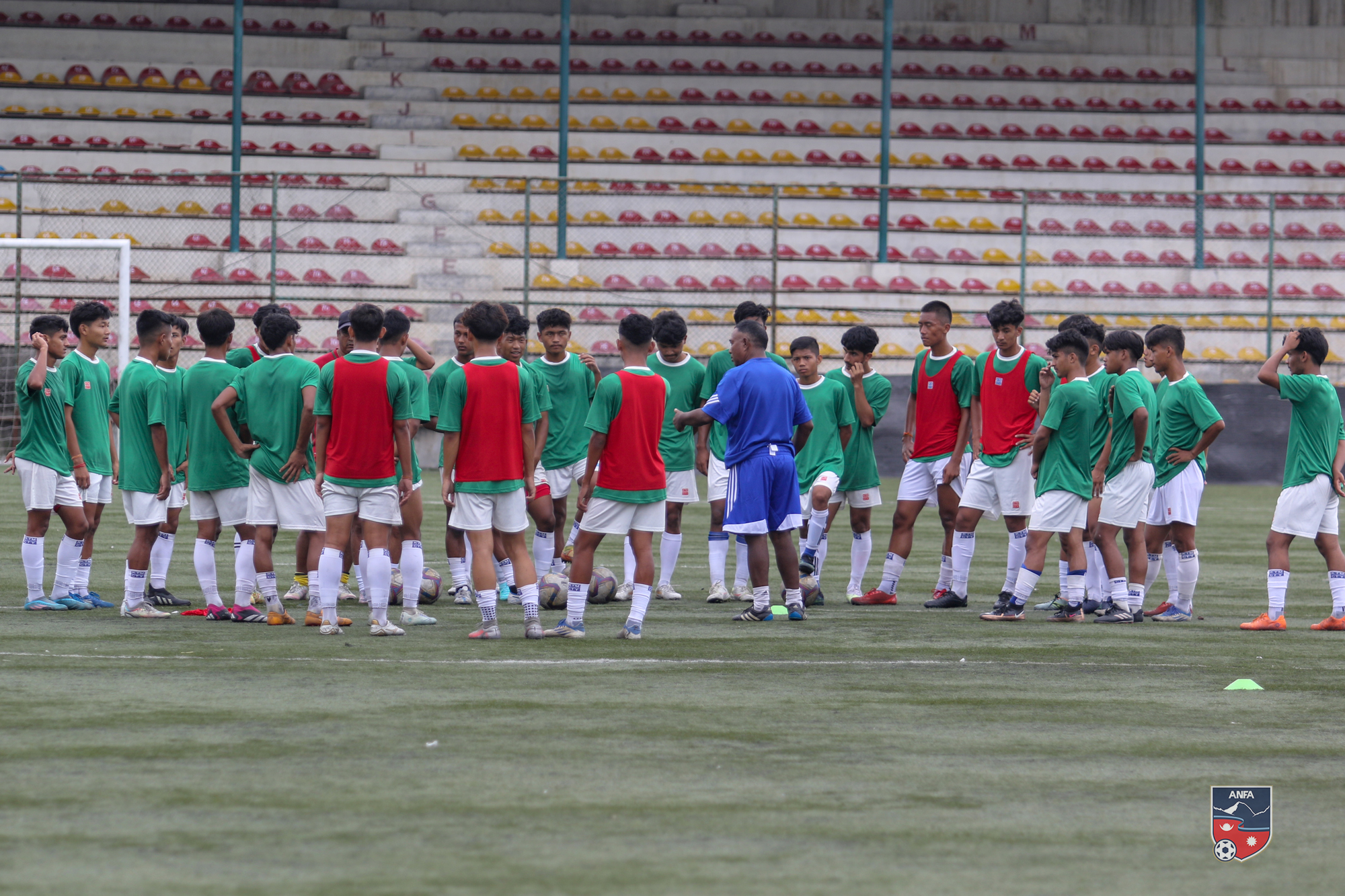
National team preparing for SAFF U-19. Photo Courtesy: ANFA
What is even more surprising is that he secured a place in the team by passing the open selection for the SAFF U-20 Championship held in Nepal last year, just like he did two years ago. Rohan is not an exception. There are many such players who secure a spot in the age-group team after passing the selection phase and face the same process every year.
Long lines, short playing time, the need to prove themselves again, and then the same selection process have been seen by young players for years. Is making proven players stand in the open selection again before every tournament a modern practice of football? Or, is it a symptom of institutional incompetence?
Lama says, “This is incompetence itself. Because practice matches of 15/15 minutes are played. If they do well in that, they get into the team, if they don’t, they are out. There is neither good coordination with unfamiliar players, nor can the player prove themselves in such a short time. Therefore, the team selects more lucky players than good ones.”
The door of transparency that ANFA is trying to create should give everyone an equal chance to enter the age-group team. But, now that door is becoming extremely tedious. Lama argues that this has taken the international practice of football, which progresses based on merit, in the opposite direction in Nepal.
If players like Rohan have represented the country once, they should be given continuity by respecting that experience and evaluating the technical aspects. A system should be established where their latest performance, attendance in training, involvement in club matches, etc., are automatically updated in a ‘database’ and evaluated on that basis. But, the situation of Nepali football is exactly the opposite now. Even though ANFA has a Technical Department, due to the lack of skilled personnel to maintain data, players are pushed into a tedious cycle.
“It is appropriate to open the door to ensure opportunities for new players. But, repeatedly making the same individuals stand in the selection line is an injustice,” Lama says, “The problem is not the open selection. The process is the same everywhere, but the objectives are different. This is neither a real competition nor a long-term structure.”
He says that if ANFA’s goal is to identify young talents, then age-group competitions should be strengthened rather than open selections.
Ending up with nothing
If ANFA’s open selection system were effective, the results should be seen on the field. But, the performance that the Nepali age-group team has been showing in recent years fully exposes the weakness of this system.
Nepali age-group football, which once had a strong presence in the Asian region, is now becoming helpless even in the SAFF region. Nepal, which won the SAFF U-19 Championship in 2015 and the U-18 Championship in 2017 in men’s football, has neither been able to repeat that achievement nor reach the final consistently since then. Reaching the final itself after an interval of seven years is now considered a great achievement. But, the moment of remaining empty-handed even after reaching close to the title after such a long effort is even more painful.
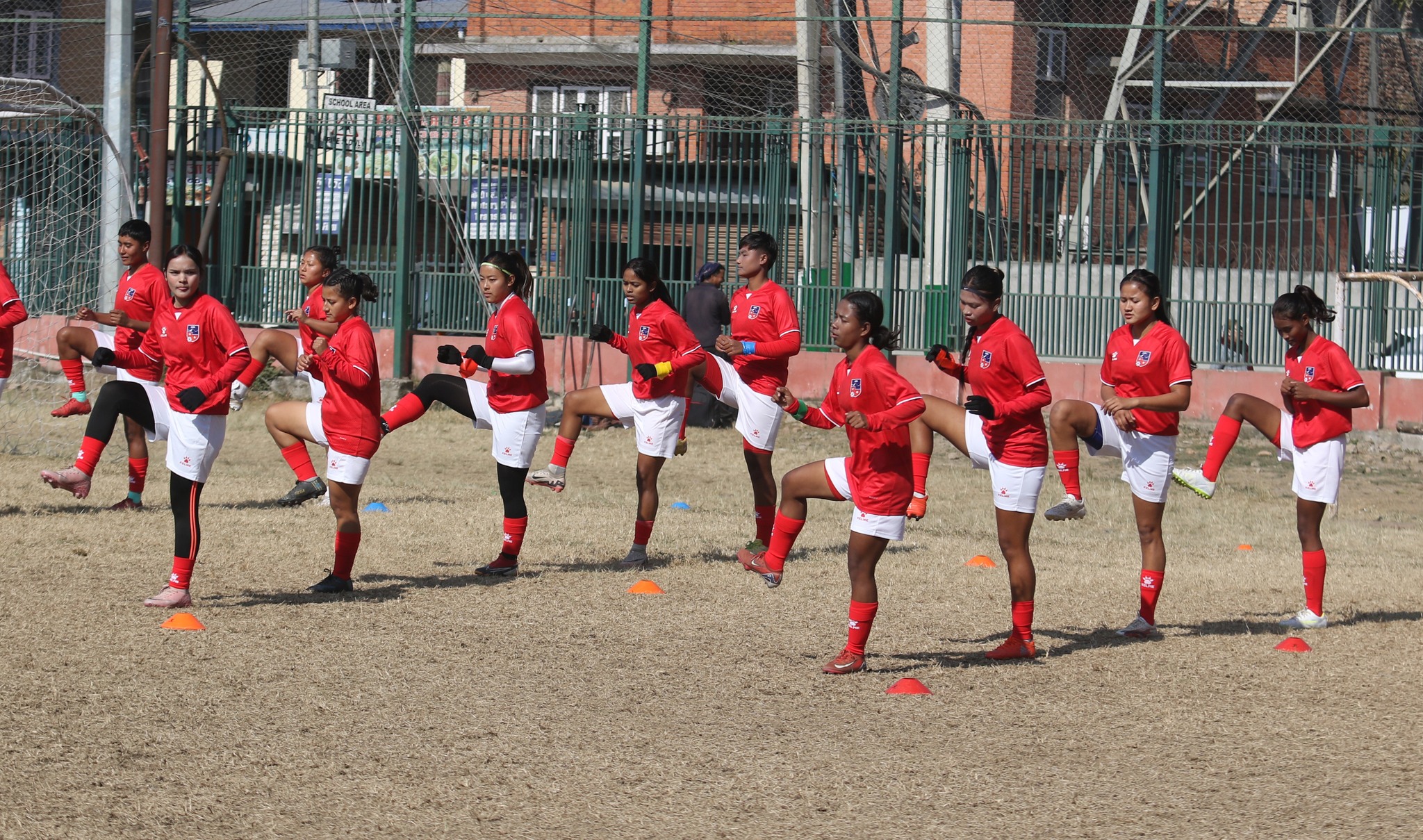
National U-19 women’s team preparing for friendly match against Bhutan. Photo Courtesy: ANFA
In the age group of women’s football, Nepal has been able to reach the final only twice after participating in five international tournaments. This series of results is being repeated. Former ANFA President Karma Tsering Sherpa says this is not a coincidence but a failure of policy, structure, and implementation. He says, “The country has 48 clubs playing in various leagues. There are districts, and under them, there are hundreds of clubs. But, we have not created a system to produce players. We create a system that only looks for players who have already arrived.”
‘We have failed’
Nabin Neupane, Head of Youth Development and Head Coach of the Nepali Women’s Team, admits that they have failed in this regard. He says that the compulsion to adopt such a long process is due to the lack of a proper system for keeping players’ records. He now claims that the performance of players in every league in Kathmandu is under the supervision of the team selection committee and expert training.
“When I was the coach, the players called for the closed training of the U-23 team were under our supervision. We called players from C to B and age groups to the team. That’s why the team was good,” he says. But, he says that it is not possible to remove the open selection in the age group right now.
The age group for women’s football still lacks a league. For men’s football, the U-16 has been held continuously for three years. The stalled U-18 league has also started to gain continuity recently. In such a situation, he says there is no option other than open selection to mobilize qualified players.
He says, “Currently, we cannot trust the district and other coaches. We had implemented scouting before. But, they started sending only close ones and relatives. That is why we have continued this process so that talented players do not lag behind.”
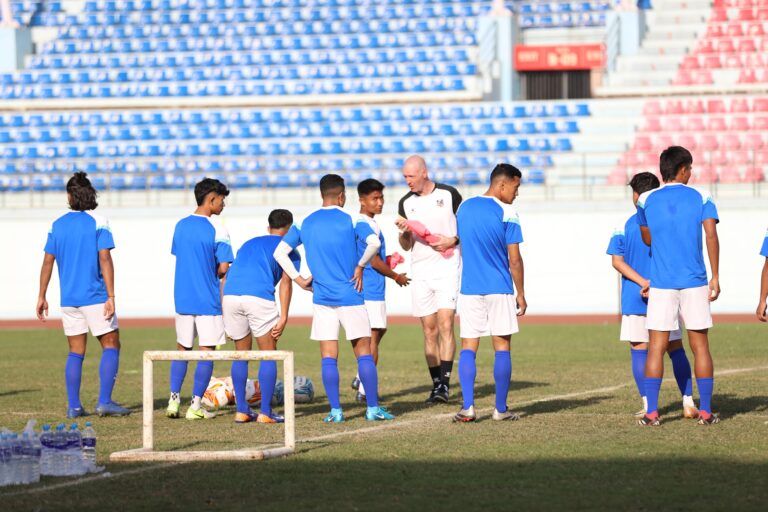
National football team with coach Matt Ross. Photo Courtesy: ANFA
Change is mandatory
The current method of player selection is just a cycle of fatigue. When the same practice of open selection is repeated, neither the ability of new players is correctly recognized, nor is the experience of those already proven respected. Such a practice has become like an informal competition that takes place once a year, which is neither scientific nor strategic.
Former goalkeeper and coach Upendra Man Singh says that the time has come to transform this into a deep evaluation and long-term vision. He says, “The potential alternatives are clear. If ANFA wants, it can adopt a system that evaluates players through the league, competition, and training.”
According to him, this is called the ‘Rolling Scouting System’. In this, coaches and scouts monitor activities throughout the season and prepare a profile of the players. Playing time, passing accuracy, fitness, and discipline are all collected, and the team is formed annually based on priority. This provides much more reliable results than the temporary evaluation of a one-day selection.
Similarly, the lack of coordination between the club and the national structure established until today is another serious weakness. He argues that by ignoring players who have been contracted by clubs or have performed excellently in the league and making everyone stand in the same line again shows distrust towards the club structure as well. Instead, he says that if regular reporting of players is made mandatory by collaborating with the ‘A’ Division League, departmental teams, and district-level centers, team selection can happen naturally.
Instead of testing players who have already been selected repeatedly, it is wiser to evaluate them through fitness and medical tests. Beep tests, sprint times, and recovery scores, these standards indicate the player’s physical condition, which is considered essential for team preparation. This reduces the burden of double selection and helps the coach make fact-based decisions.
Singh says that the management of football cannot proceed without adopting technology now. Player scouting and evaluation in world football are based on technology. He says that he himself created the department to bring such a system to Nepal. He says that those departments should bring together the player’s match data, video analysis, coach’s comments, and fitness report in one place.
He says this makes the decision transparent and helps keep it away from access, recommendation, or influence. “If players who have proven themselves within the football system are repeatedly asked to provide proof again, it can be openly said that the institution’s intention is flawed,” he says.